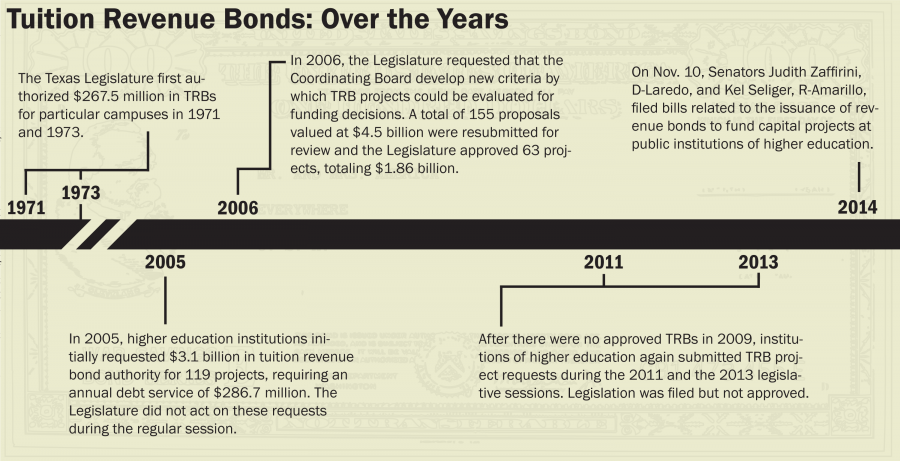For the 2015 legislative session, the UT System is seeking funding from the Texas Legislature for large infrastructure projects at each of its educational institutions through tuition revenue bonds.
In a July meeting, the Board of Regents approved the System’s plan to request $1.9 billion in tuition revenue bonds, also known as TRBs, from state lawmakers. UT-Austin’s share in the proposal includes two building renovation projects: $100 million for Welch Hall and $105 million for the McCombs School of Business.
If authorized, the proposed TRBs will pledge a revenue stream serviced by income from tuition charges levied against students with the expectation that the state will later reimburse the expenditures.
Barry McBee, System vice chancellor and chief governmental relations officer, said the lack of TRBs has contributed to overcrowding in classrooms and more limited access to laboratories at many of Texas’ public universities. While the System has used funding alternatives, such as the state’s Permanent University Fund and philanthropic contributions, to keep some projects afloat, they are not enough to meet all the needs of higher education institutions, according to McBee.
“A good example in Austin would be the engineering building; that was a TRB request last time,” McBee said. “It was the highest priority for UT-Austin, and it was obviously not funded, but we were able to put together funding for the project to proceed. That probably means that some other priority project on the campus had to be delayed.”
The legislature historically passed new TRB legislation every other session, but lawmakers have not authorized new TRBs since a third-called session in 2006. Up until 2013, TRBs were consistently passed over because of budget concerns, according to McBee.
“Higher education collectively had an expectation in 2009 that we would return to what we call a TRB session,” McBee said. “But it was really something the state just could not afford at that time and it was sort of cut off again in 2011.”
In 2013, the House of Representatives and Senate proposed different versions of TRB legislation but, in the last days of the session, failed to pass a bill. McBee said 2015 is the next opportunity to negotiate with legislators over the need for state support for construction.
State Sen. Kel Seliger, R-Amarillo, filed Senate Bill 150, a $2.86 billion proposal that would fund 64 construction and renovation projects at higher education institutions across the state with cash either from direct appropriation or from the Rainy Day Fund, a savings fund that allows the state to set aside surpluses in revenue for use in times of unexpected revenue shortfall.
Another construction financing bill, filed by State Sen. Judith Zaffirini, D-Laredo, proposes roughly $5 billion for infrastructure projects, according to Seliger.
“If we’re going to take money from the Rainy Day Fund, which I think is a legitimate way to do it, a $2.85 billion dollar subtraction is far more feasible than something over $5 billion,” Seliger said.
Sean Griffin, Zaffirini’s chief of staff, said Zaffirini wanted to take a broader approach with her bill, potentially granting institutions more funding. The bill’s cost will likely change to reflect the legislature’s budget and priorities.
“Our bill is different because we want to discuss it with the entire legislature; it’s an open discussion of where we should put our resources,” Griffin said.
Seliger said he believes his bill, if passed, will help universities make significant progress in terms of infrastructure without piling on excess debt.
“I’m not a big believer in debt,” Seliger said. “I think it appropriates forward to the tune of $200-250 million dollars every biennium for a long time, and, if you have the cash for one-time projects to fund and then not deal with again, I think that’s a good opportunity.”
University spokesman Gary Susswein said TRBs are an important factor in funding new building construction as well as keeping tuition stable.
“We used these bonds to build the Seay Building in the late 1990s and the Norman Hackerman Building in the late 2000s,” Susswein said. “These facilities have ensured that our students and faculty have access to state-of-the-art lab space and classrooms.”
According to Susswein, the failure to pass TRB legislation in recent years has made it more difficult for the University to maintain state-of-the-art facilities.
“Our goal of becoming the top public research institution in the nation is far more difficult to achieve without access to adequate funding, including tuition revenue bonds,” Susswein said.
McBee said he is cautiously optimistic that lawmakers will approve TRB legislation in the upcoming session.
“We recognize legislators have to make difficult decisions about funding Medicaid and roads, and public education, and higher education,” McBee said. “We would hope that the collective voice of higher education pointing out our needs will be persuasive to the legislature.”





















